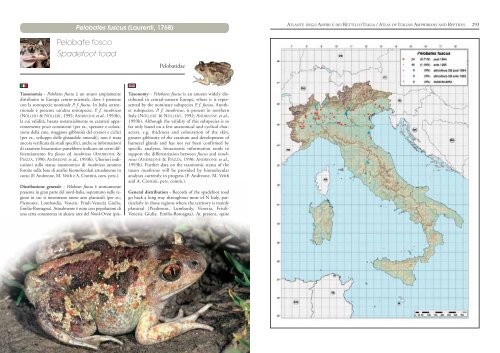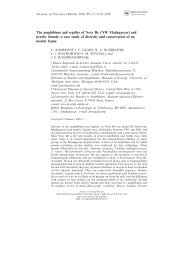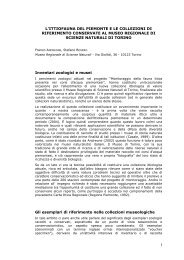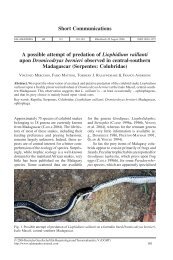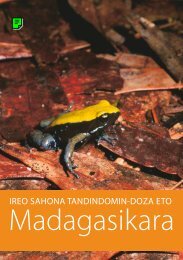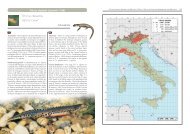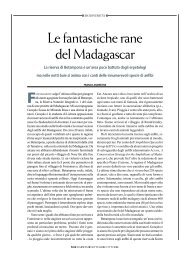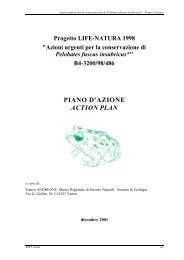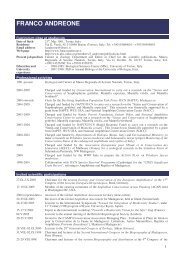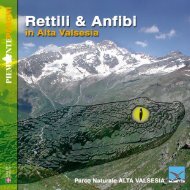Pelobate fosco Spadefoot toad - Franco Andreone
Pelobate fosco Spadefoot toad - Franco Andreone
Pelobate fosco Spadefoot toad - Franco Andreone
You also want an ePaper? Increase the reach of your titles
YUMPU automatically turns print PDFs into web optimized ePapers that Google loves.
<strong>Pelobate</strong>s fuscus (Laurenti, 1768)ATLANTE DEGLI ANFIBI E DEI RETTILI D’ITALIA / ATLAS OF ITALIAN AMPHIBIANS AND REPTILES 293<strong>Pelobate</strong> <strong>fosco</strong><strong>Spadefoot</strong> <strong>toad</strong>PelobatidaeTassonomia - <strong>Pelobate</strong>s fuscus è un anuro ampiamentedistribuito in Europa centro-orientale, dove è presentecon la sottospecie nominale P. f. fuscus. In Italia settentrionaleè presente un’altra sottospecie, P. f. insubricus(NÖLLERT & NÖLLERT, 1992; ANDREONE et al., 1993b),la cui validità, basata sostanzialmente su caratteri apparentementepoco consistenti (per es., spessore e colorazionedella cute, maggiore gibbosità del cranio) e ciclici(per es., sviluppo delle ghiandole omerali), non è stataancora verificata da studi specifici, anche se informazionidi carattere bioacustico parrebbero indicare un certo differenziamentofra fuscus ed insubricus (ANDREONE &PIAZZA, 1990; ANDREONE et al., 1993b). Ulteriori indicazionisullo status tassonomico di insubricus sarannofornite sulla base di analisi biomolecolari attualmente incorso (F. <strong>Andreone</strong>, M. Veith e A. Crottini, com. pers.).Distribuzione generale - <strong>Pelobate</strong>s fuscus è storicamentepresente in gran parte del nord-Italia, soprattutto nelle regioniin cui si incontrano estese aree planiziali (per es.,Piemonte, Lombardia, Veneto, Friuli-Venezia Giulia,Emilia-Romagna). Attualmente è noto con popolazioni diuna certa consistenza in alcune aree del Nord-Ovest (pia-Taxonomy - <strong>Pelobate</strong>s fuscus is an anuran widely distributedin central-eastern Europe, where it is representedby the nominate subspecies P. f. fuscus. Anothersubspecies, P. f. insubricus, is present in northernItaly (NÖLLERT & NÖLLERT, 1992; ANDREONE et al.,1993b). Although the validity of this subspecies is sofar only based on a few anatomical and cyclical characters,e.g. thickness and colouration of the skin,greater gibbosity of the cranium and development ofhumeral glands and has not yet been confirmed byspecific analyses, bioacoustic information tends tosupport the differentiation between fuscus and insubricus(ANDREONE & PIAZZA, 1990; ANDREONE et al.,1993b). Further data on the taxonomic status of thetaxon insubricus will be provided by biomolecularanalyses currently in progress (F. <strong>Andreone</strong>, M. Veithand A. Crottini, pers. comm.).General distribution - Records of the spadefoot <strong>toad</strong>go back a long way throughout most of N Italy, particularlyin those regions where the territory is mainlyplanitial (Piedmont, Lombardy, Venetia, Friuli-Venezia Giulia, Emilia-Romagna). At present, quite
294 <strong>Pelobate</strong> <strong>fosco</strong> - <strong>Spadefoot</strong> <strong>toad</strong>ATLANTE DEGLI ANFIBI E DEI RETTILI D’ITALIA / ATLAS OF ITALIAN AMPHIBIANS AND REPTILES 295nura a sud di Torino, Eporediese (TO), pianura novarese,Lomellina (PV), colline del Varesotto, pianura cremonese),e con segnalazioni sporadiche in provincia di Mantova,Ferrara, Ravenna, Venezia e Pordenone (ANDREONE etal., 1993b; MAZZOTTI & RIZZATI, 2002).Commento alla carta di distribuzione - La carta di distribuzioneevidenzia il limitato numero di segnalazioni relative aP. fuscus, con la maggior quantità di quadranti occupati soprattuttoin Piemonte. Tale abbondanza nel settore nord-occidentaleè probabilmente da imputare ad una differente attivitàdi ricerca, anche se laddove si incontrano le popolazionipiù importanti l’agricoltura è caratterizzata da una minoreindustrializzazione, ad eccezione dell’area risicola.Habitat - <strong>Pelobate</strong>s fuscus, al pari delle altre specie del genere,è un anuro fossorio, caratterizzato dalla presenza disperoni metatarsali particolarmente sviluppati, cranio osseo“corazzato” e corpo globulare con arti non molto sviluppati.Esso è generalmente presente in aree con terrenosabbioso o comunque tale da permettergli un agevole interramento.Per il resto P. fuscus non manifesta apparentementeuna notevole selettività degli habitat frequentati,anche se sembra (in base ai pochi dati disponibili) che perriprodursi colonizzi con maggior frequenza siti acquaticitemporanei. Di solito esso è rinvenibile in ambienti aperti,anche se è evidente che, almeno in alcuni casi, può esserepresente all’interno dei boschi. Interessante, da un puntolarge populations are known of in some areas of thePo Basin (the plains south of Turin, the area surroundingIvrea, the Novara plains, Lomellina (Paviaprovince), hills in the Varese province, plains of Cremonaprovince). Sporadic sightings have also been reportedin the provinces of Mantua, Ferrara, Ravenna,Venice and Pordenone (ANDREONE et al., 1993b;MAZZOTTI & RIZZATI, 2002).Comment to the distribution map - The distributionmap shows scarce reporting of P. fuscus, with thegreatest number of occupied squares in Piedmont.We guess that this is due to scarcity of research inother areas rather than to a truly greater abundanceof P. fuscus in this region, although it must also benoted that the largest populations occur in the areaswhere agriculture is less intensive, with the exceptionof rice cultivating areas.Habitat - Like the other species of this genus <strong>Pelobate</strong>sfuscus is a fossorial anuran with highly developedmetatarsal spurs, a robust, bony cranium, a globularbody, and relatively undeveloped legs. It is found in areaswith sandy soil or a substrate sufficiently soft to allowit to burrow. Beyond this requirement, P. fuscusdoes not appear to be very selective of habitat, althoughthe limited available data suggest that in the reproductiveperiod it most frequently colonises tempo-di vista adattativo, è anche la sua presenza in aree risicoledel Novarese, Vercellese e della Lomellina, dove talora èanche localmente abbondante, molto probabilmente acausa della notevole disponibilità alimentare e della temporaneitàdelle risaie stesse.Distribuzione altitudinale - <strong>Pelobate</strong>s fuscus è un tipico anfibioplaniziale. Sulla base dei dati raccolti nel corso delleindagini per l’Atlante esso presenta una distribuzione da 1a 370 m, con una media di 195 ± 87 m.Periodo di attività nell’anno - Il pelobate <strong>fosco</strong> è un anfibiocon riproduzione “esplosiva” (ANDREONE, 1995;FORTINA & ANDREONE, 1999); esso conduce vita notturnaper buona parte dell’anno, divenendo parzialmentediurno solo durante la stagione riproduttiva. La ripresadell’attività in primavera avviene in occasione delle pioggeda fine marzo a fine aprile. In tale periodo, caratterizzatoda una temperatura minima elevata (7-10 °C), glianimali escono dai nascondigli invernali e si dirigono inmassa verso i siti riproduttivi. Nell’arco di pochi giorni(eccezionalmente di poche settimane) avviene la riproduzione.Di seguito a ciò i pelobati abbandonano nuovamenteil sito. Solo una ricerca finalizzata ha permesso diverificare l’attività epigea del pelobate in periodi non riproduttivi(A. Gentilli e S. Scali, com. pers.). I girini sisviluppano nell’arco di poche settimane e solitamenteprima dell’estate sono già metamorfosati.rary aquatic sites. It is usually observed in open heathareas, and is sometimes also found in forest areas. It isinteresting to note that it is also found in rice cultivationsin Novara, Vercelli, and Pavia provinces, wherelocally dense populations are present. This is most likelydue to the abundant availability of food, and to thetemporary flooding of the rice fields.Altitudinal distribution - <strong>Pelobate</strong>s fuscus is a typicalplanitial amphibian. Altitudinal distribution rangesfrom 1 to 370 m, with a mean height of 195 ± 87 m.Annual activity cycle - The spadefoot <strong>toad</strong> is an amphibianwith an explosive breeding pattern (AN-DREONE, 1995; FORTINA & ANDREONE, 1999). It leadsa nocturnal life for most of the year, becoming partlydiurnal only during the breeding season. Annual activityafter the winter latency starts during the springrains, from the end of March to the end of April. Duringthis period, when temperatures range from 7-10°C, individuals leave their burrows, and move in massto breeding sites. Breeding takes place over a few days(in rare cases a few weeks). The spadefoots then abandonthe breeding site. Investigation has confirmed thatspadefoots show a limited epigean activity during nonreproductiveperiods (A. Gentilli and S. Scali, pers.comm.). Tadpoles grow rather quickly and usuallymetamorphose before the summer.<strong>Pelobate</strong> <strong>fosco</strong>,accoppiamento e uova(Cameri, Novara)––––––––––Mating pair and eggs ofspadefoot <strong>toad</strong>(Cameri, Novara)<strong>Pelobate</strong> <strong>fosco</strong>, giovane albinotico (Cameri, Novara)––––––––––Albinotic froglet of spadefoot <strong>toad</strong> (Cameri, Novara)<strong>Pelobate</strong> <strong>fosco</strong>, adulto (Provincia di Torino)––––––––––Adult of spadefoot <strong>toad</strong> (Province of Turin)
296 <strong>Pelobate</strong> <strong>fosco</strong> - <strong>Spadefoot</strong> <strong>toad</strong>ATLANTE DEGLI ANFIBI E DEI RETTILI D’ITALIA / ATLAS OF ITALIAN AMPHIBIANS AND REPTILES 297Riproduzione - La riproduzione avviene in corpi d’acqua,preferibilmente temporanei, soprattutto di origine antropica(stagni permanenti a uso irriguo, ex-maceratoi, pozze ecanali di drenaggio). La stagione riproduttiva ha indicativamenteinizio fra marzo e aprile (ANDREONE & PAVIGNANO,1988; ANDREONE et al., 1993b; FORTINA & ANDREONE,1999; P. Bergò, com. pers.), anche se può essere anticipataalla fine di febbraio o posticipata a maggio in caso di primaveresiccitose (ANDREONE et al., 1993b). L’amplesso è di tipoinguinale, ed è accompagnato da vocalizzazioni emessesott’acqua da entrambi i sessi (ANDREONE & PIAZZA, 1990;ANDREONE et al., 1993b). Le uova sono deposte in cordonigelatinosi alquanto lassi, lunghi alcune decine di cm e ancoratia piante acquatiche e ad altri oggetti sommersi. Le larvehanno un regime alimentare prevalentemente erbivoro e detritivoro,e, in due-tre mesi, possono raggiungere la dimensionedi 120 mm. A differenza di quanto riportato per la sottospecienominale (NÖLLERT & NÖLLERT, 1992) non sonostati finora segnalati casi naturali di prolungamento del periodolarvale, con permanenza in acqua durante l’inverno.Benché non siano stati ancora condotti studi sull’età dellepopolazioni naturali, è verosimile che la maturità sessuale siaraggiunta dopo uno-due anni.Status delle popolazioni in Italia - <strong>Pelobate</strong>s fuscus è consideratouno degli Anfibi europei maggiormente minacciatidi estinzione, a fronte soprattutto del decremento di segnalazioniavvenuto dalla fine del secolo scorso ai giorni nostriReproduction - Reproduction takes place in temporarywater bodies, especially those of human origin(irrigation reservoirs, abandoned textile dyeing pitsand drainage pools and ditches). It begins in March-April (ANDREONE & PAVIGNANO, 1988; ANDREONEet al., 1993b; FORTINA & ANDREONE, 1999; P. Bergò,pers. comm.), although it can be brought forward tothe end of February or delayed until May (AN-DREONE et al., 1993b) in very dry springs. Amplexusis inguinal, and is usually accompanied by vocalisationsemitted underwater by both sexes (ANDREONE& PIAZZA, 1990; ANDREONE et al., 1993b). The eggsare then deposited in loose jelly strings a few centimetreslong, anchored to aquatic plants and otherunderwater objects. The larvae are almost totally herbivorousor detritivorous and in two-three monthscan reach a length of about 120 mm. In contrast towhat has been reported for the nominate subspecies(NÖLLERT & NÖLLERT, 1992), there is so far no evidenceof prolongation of the larval period with overwinteringin the water. Although there are no studiesyet on the age structure of this anuran, it is likely thatsexual maturity is reached after one-two years.Status of the populations in Italy - <strong>Pelobate</strong>s fuscus isconsidered one of the most threatened European amphibians,especially given the reduction in the numberof known breeding sites since the end of the last(CORBETT, 1989; BALLETTO, 1993). A causa della sua raritàP. fuscus è stato inserito nella lista rossa IUCN (GROOM-BRIDGE, 1993) ed è citato con particolare attenzione in diversecategorizzazioni dell’erpetofauna italiana (ANDREONE& LUISELLI, 2000). Allo stato attuale delle nostre conoscenzesono poche le popolazioni di una certa consistenza;fra queste quelle del Novarese, dell’Eporediese, del comprensorioa sud di Torino, del Varesotto e, probabilmente,del Cremonese. Le altre segnalazioni sono estremamenteoccasionali e puntiformi. D’altra parte la biologia stessadella specie la rende estremamente schiva e difficile da osservarein natura, ed è verosimile che la scarsità di segnalazionisia anche da imputare ad un difetto di ricerca nei momentiopportuni dell’anno (quando gli individui sono inattività riproduttiva). Gran parte delle popolazioni, tuttavia,ricade in aree a elevato impatto agricolo, con prevalenzadi risicolture, colture foraggiere e, talora, ortive o legnose.Nei dintorni di Ivrea il pelobate è noto anche in alcunisiti collocati tra campi di mais e prati e in stagni temporanei.La scomparsa delle popolazioni è probabilmente dovutaa diverse cause, fra cui l’alterazione dell’ambiente terrestre,l’incremento dell’agricoltura intensiva, e il disturbonei siti acquatici con introduzione di ittiofauna. A causadella sua rarità e vulnerabilità il pelobate <strong>fosco</strong> è da alcunianni oggetto di iniziative di salvaguardia: di particolaremenzione è il “Progetto <strong>Pelobate</strong>”, coordinato dal WWFalla fine degli anni ‘80 e primi anni ‘90, e, più di recente, ilpiano di conservazione della Regione Lombardia (SCALI etal., 2001b) e le attività nell’ambito di progetti LIFE, con lapartecipazione del WWF, dell’Acquario di Genova e dellaRegione Piemonte (ANDREONE et al., 2004a).century (CORBETT, 1989; BALLETTO, 1993). Due toits rarity P. fuscus is included in the IUCN red list(GROOMBRIDGE, 1993), and is accorded special statusin categorisation analyses of the Italian herpetofauna(ANDREONE & LUISELLI, 2000). Only a few abundantpopulations are known of at present: these are foundin the areas surrounding Novara and Ivrea; the areasouth of Turin, the Varese area and probably the Cremonaprovince. Other sightings are very rare and isolated.The species is, however, very shy and hard tofind, and it is likely that the scarcity of observationsis due to a lack research at the optimal time of year(i.e. the reproductive period). Most of the populationsare found in intensive agricultural areas wherericefields, wheat fields and meadows are prevalent.Around Ivrea the spadefoot has been found in breaksbetween maize fields and meadows as well as in temporaryponds. The disappearance of spadefoot populationsis likely due to several causes, including the alterationof their habitat, the increase in intensiveagriculture, and the disturbance of aquatic sites includingthe introduction of fish. Due to its rarity andvulnerability, a number of conservation initiativeshave been undertaken over the years to protect thespadefoot <strong>toad</strong>. These include the <strong>Pelobate</strong>s Projectcarried out in the late eighties and early nineties andcoordinated by the WWF; the more recent LombardyRegion conservation plan (SCALI et al., 2001b); andthe joint contribution in the ambit of the LIFE projectsof the WWF, the Aquarium of Genoa and thePiedmont Region (ANDREONE et al., 2004a).FRANCO ANDREONE<strong>Pelobate</strong> <strong>fosco</strong>,accoppiamento(Cameri, Novara)––––––––––Mating pair of spadefoot<strong>toad</strong> (Cameri, Novara)


